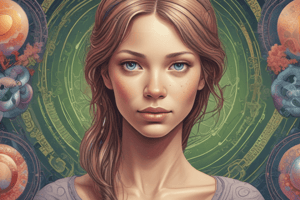Podcast
Questions and Answers
Which gas is a waste product of respiration and used by plants in photosynthesis?
Which gas is a waste product of respiration and used by plants in photosynthesis?
- Oxygen
- Hydrogen
- Carbon dioxide (correct)
- Nitrogen
What term best describes an organism that lives on or in another and can cause disease?
What term best describes an organism that lives on or in another and can cause disease?
- Parasite (correct)
- Vector
- Host
- Microbe
Which of the following acts as a physical barrier to prevent germs from entering the body?
Which of the following acts as a physical barrier to prevent germs from entering the body?
- Skin (correct)
- Mucus
- Bacteria
- Hormones
What is the main function of the respiratory system?
What is the main function of the respiratory system?
Which part of the respiratory system is a muscle below the lungs that aids in breathing?
Which part of the respiratory system is a muscle below the lungs that aids in breathing?
What term describes the process of joining a male sex cell and a female sex cell?
What term describes the process of joining a male sex cell and a female sex cell?
Which term refers to the chemicals in the body that cause changes during puberty?
Which term refers to the chemicals in the body that cause changes during puberty?
What are the male sex cells called?
What are the male sex cells called?
What is the primary function of the reproductive system?
What is the primary function of the reproductive system?
Which of the following occurs during fertilization?
Which of the following occurs during fertilization?
During puberty, what is one of the significant changes that occur in boys?
During puberty, what is one of the significant changes that occur in boys?
Menstruation begins approximately how long after a girl starts puberty?
Menstruation begins approximately how long after a girl starts puberty?
Which of these is NOT typically a change associated with puberty?
Which of these is NOT typically a change associated with puberty?
What is the main function of the sperm duct in the male reproductive system?
What is the main function of the sperm duct in the male reproductive system?
Where does fertilization typically take place in the female reproductive system?
Where does fertilization typically take place in the female reproductive system?
Which of the following is classified as a non-living entity that replicates by infecting host cells?
Which of the following is classified as a non-living entity that replicates by infecting host cells?
Flashcards are hidden until you start studying
Study Notes
Respiratory System
- Oxygen and carbon dioxide are gases that make up part of the air.
- The respiratory system allows breathing in oxygen and out carbon dioxide.
- The respiratory system includes the nose, trachea, lungs, and diaphragm.
- Breathing includes inhalation (breathing in) and exhalation (exhaling).
- Common respiratory issues include asthma, bronchitis, and pneumonia.
- Good hygiene, air quality, exercise, and avoiding smoking maintain respiratory health.
Reproductive System
- Puberty is when the body changes and one becomes capable of reproduction.
- Puberty starts at different ages for boys (around 13) and girls (around 11).
- Hormones cause changes during puberty and are chemicals produced by the body.
- Boys grow taller during puberty (up to 10cm per year). Girls also grow taller during this time (up to 12cm per year).
- Hair grows on the body and face for both boys and girls.
- Skin changes occur, and the skin becomes oily.
- Body shapes, including shoulders, chest, and hips change.
- Voice deepens in both boys and girls.
- Boys produce sperm and girls produce eggs (ova).
- Fertilization is the joining of sperm and egg for reproduction.
Microorganisms
- Bacteria, viruses, and fungi are microorganisms.
- Some microorganisms are helpful (bacteria in food production).
- Some microorganisms cause disease.
- Microorganisms can spread through air, water, touch, or insects.
- Physical and chemical barriers protect the body against microbes.
- Skin acts as a physical barrier against germs, and stomach acid kills germs.
Infectious Diseases
- Infectious diseases are illnesses caused by tiny germs (bacteria, viruses, parasites).
- These germs can spread from one living thing to another.
- Symptoms of infectious diseases include fever, cough, tiredness, and stomach issues.
- Mucus traps germs in the nose, throat, and other air passages.
Key Facts About Puberty and Reproductive System
- Boys and girls experience changes in reproductive system during puberty.
- The reproductive system's role is to produce special cells required for reproduction.
- Sperm is the male reproductive cell and ova are female.
- Fertilization is the joining of the sperm and egg to create a new living being. This new living being will develop into a baby.
Studying That Suits You
Use AI to generate personalized quizzes and flashcards to suit your learning preferences.




